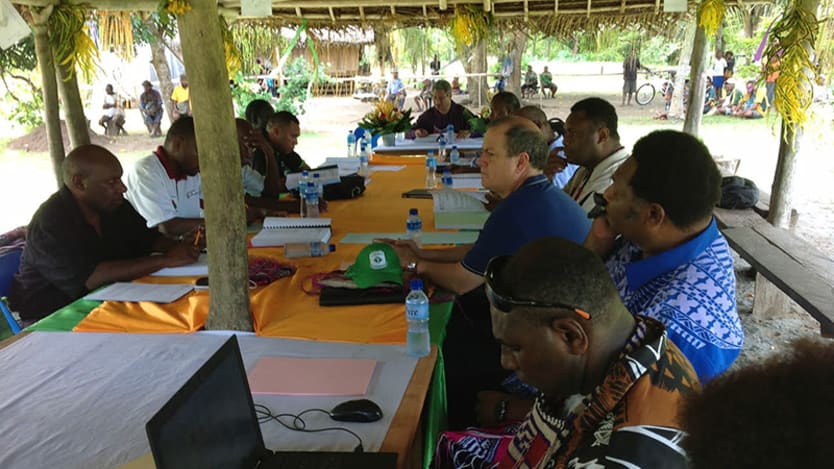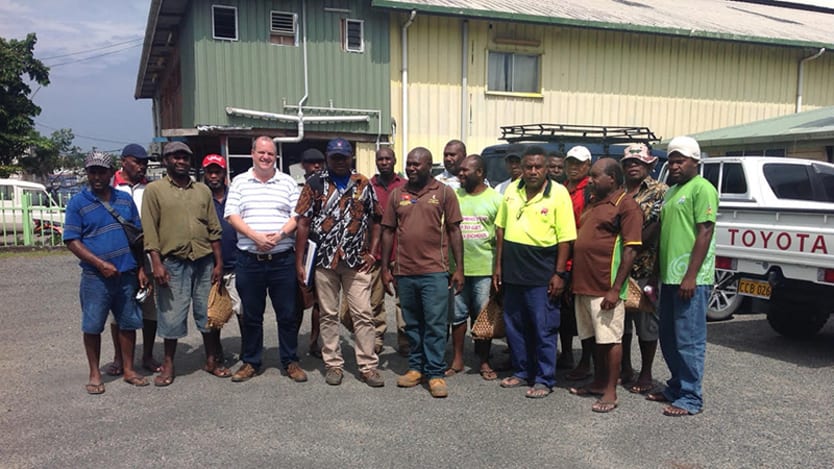
CANBERRA — Thanks to the Sustainable Development Goals, the world has big targets to meet by 2030 — environmentally, economically, and socially. And to meet and surpass the targets, new approaches are needed.
Technology and partnerships with the private sector are important ways of increasing reach. But to create sustainable change among the most vulnerable and at-risk areas of society, communication and engagement will be key.
According Ninti One and i2i Development — two Indigenous Australian businesses partnering with the Department of Foreign Affairs and Trade in delivering Australia’s international development program — an indigenous approach is required in order to recognize those in developing countries who are indigenous with strong ties to culture and land. Those from the development sector who communicate and engage with the indigenous in the developing world need to be Indigenous themselves to similarly understand the importance of their culture and land.
What is the indigenous approach to development?
See more stories on Australian aid:
► What can the Australian census tell us about Australia's response to the global refugee crisis?
► Calls for tighter legislation on Australian businesses in wake of Solomon Islands mining controversy
► Localization moves from advocacy to implementation in Indo-Pacific
► Politics and development: Insights from dialogues in Canberra
According to Rod Reeve, managing director of Ninti One, an indigenous approach to development puts community at the center. “This is quite a contrast to traditional suppliers who will focus on the donor and the government,” Reeve explained to Devex. “The difference is astounding. A big mistake we keep making is that we don’t always acknowledge and recognize the hundred and thousands of years of knowledge that exists in communities. When consultants and outsiders come along, they don’t always appreciate and value it.”
For Australia in particular, Reeve explained that much of the aid program is government to government. Aid program objectives aim to deliver change to both government and citizens. “Whereas Indigenous suppliers try to put community at the focus. What this means on the ground is that Indigenous suppliers have a greater focus on the community — and they will engage with local Indigenous communities to understand their concerns and work with them to create change.”
Peter Dunn, global indigenous economic development advisor for i2i Development, explained to Devex that an indigenous-to-indigenous approach builds strong trust and rapport with communities — and can create a passion to drive change. “We mobilize and export indigenous talent to work with people for their own prosperity,” he said. “Initially, I worked with the government agenda and the media’s agenda, which stereotyped indigenous people as being disadvantaged. But over the years there has been a growing stream of professionals recognizing their culture, believing in their culture, and understanding the importance of extended family ... indigenous people recognize this in others and it builds the trust and repour needed to support change.”
It is an approach that can only be fully delivered by an indigenous person or group. “Colonial people can be respectful of culture and talented, but will still always bring a stereotypical perception to indigenous communities,” Dunn said. “And this means you cannot be as effective.”

Indigenous to indigenous in action: Building an agribusiness in Papua New Guinea
With the support of DFAT, i2i Development have received a grant to put theory into action to demonstrate the difference an indigenous approach can deliver.
In Papua New Guinea, i2i Development has been contracted to deliver a private sector development agribusiness project, which seeks to change how cocoa farming is currently managed in the country — from low production with farmers treating the commodity as an ATM when they need money, to a real company where local indigenous farmers, women, and schools are shareholders who receive a financial stake in its success. The outcome will be the PNG Agriculture Company (East New Britain).
In encouraging local indigenous communities to build a company, showing the success of Australians building indigenous businesses has been important. “We had indigenous people speak to the communities, and in response an elder of the community stood up and said ‘Listen everyone, our brothers from Australia have come to share their brains. Are we going to borrow their brains and get a business going?’” For Dunn, this was an important moment in understanding how impactful the approach is.
The response has been similar in work to empower women in remote and regional communities.
“Carla McGrath — an indigenous woman who has worked in PNG for i2i on women’s empowerment — introduced herself to local indigenous women saying her father was Torres Strait, mother Melanesian, and she believed in her culture,” Dunn said. “And through this she was able to quickly build trust and rapport with these local women to create change.”
The agribusiness program has grand goals. Starting with 200 farmers, it will increase to 20,000 in five years and expand to include schools to encourage youth to see a future in farming — whether this is hands-on, developing innovative support solutions, or creating entrepreneurial ideas to expand the reach and impact of the company.
“This has never been done before, but the Australian High Commission is pleased with the progress we are making,” Dunn said. And the response from elsewhere in the Australian aid program and PNG government have been equally positive with high hopes for the outcomes.
What evidence exists for the value of an indigenous approach?
For the communities Dunn engages with, the indigenous approach appears common sense. Going into a new community with shared ideals and values is important when trying to engage a new group. An outsider is less effective.
“At the moment, it is all anecdotal,” Dunn said. “Indigenous people see it as a no-brainer, but we want the evidence to show this is a more effective way for countries — including Australia and Canada — to deliver aid.”
i2i Development are currently undertaking research with Australian National University and the University of Melbourne to build this evidence of the impact of the indigenous-to-indigenous approach. For Reeve, it is an important body of work. “Just like anyone else, I have the same questions on what are the differences between an indigenous and traditional development response, but who can I call?” Reeve asked. “The current knowledge and evidence base is poor.”
To communicate the value to the “traditional” side of development, tangible results and written reports are needed.
For Reeve, filling the gaps between indigenous communities and government can also help — especially in evaluating impact. “We have been developing an exciting approach to evaluate impact to match community and government needs,” he said. “For communities, we evaluate impact in storytelling form. With government, their need is usually in numbers — metrics and dollars. It’s an approach that is starting to take off and demonstrate shared value.”
Encouraging wide use and acceptance
See more stories on inclusive development:
► Opinion: Land ruling threatens Brazil’s indigenous peoples ― and its climate commitments
► Indigenous leaders lament disconnect between SDG indicators and reality at UN
► Q&A: Tim Lo Surdo on how to bring a voice to Australia's communities of color
According to Reeve, there is still limited engagement of an indigenous-to-indigenous approach within the Australian aid program. Ninti One itself has assisted DFAT in six or seven small contracts that he believed wouldn’t add up to more than 100,000 Australian dollars ($80,000).
Australia has an Indigenous Procurement Policy that encourages the government to look to indigenous businesses for services — defined as businesses with 50 percent or more indigenous ownership — and a target of indigenous procurement to account for 3 percent of all agency procurements by 2030. But within DFAT, Reeve believed much of the procurement has been contracted within areas such as corporate and security. The aid program is yet to be a priority area for engaging indigenous businesses.
Advocates within donor agencies, NGOs, and private sector companies are important in delivering change, which needs to occur at the policy level. For Reeve and Dunn, conversations are occurring with procurement officers, the secretary of DFAT, and even ministers. And they both agree there is good will toward engaging indigenous suppliers within the aid program to implement programs from their perspective to support nearby indigenous communities in the Indo-Pacific region.
But this goodwill has yet to convert to large aid contracts that identify the relevance of the Indigenous Procurement Policy, including the recent projects out for tender such as Water for Women Fund and Aus4Transport. “The policy framework is there for Australia, including the rights for indigenous people, so the pillars and foundations are in place,” Reeve said. “But it comes down to the people on the ground making the policy decision that indigenous procurement is important in achieving development outcomes.”
Education will lead to change, including educating large aid contractors, who Dunn believes can be conservative in their engagement with indigenous communities in developing countries. “There are not many of the big players that have picked up on the indigenous engagement aspect — including Cardno and Coffey — to any significant level.”
And without widespread acceptance and engagement in the aid program, the number of indigenous businesses offering services to the aid program are limited. “By our assessment, we believe it is just us and i2i that are active in this space,” Reeve told Devex.
Demand, Reeve said, will lead to supply and more indigenous Australians considering a career in development.
Where is the future of the indigenous approach?
Both Dunn and Reeve are excited about the potential and prospects for an indigenous approach — and the work is being recognized internationally, with i2i Development put up to the U.N. as a best practice case for indigenous business.
Programs that can benefit are many and varied.
Indigenous education professionals could play an important role in the delivery of Australian funding to support education in Myanmar, where a National Education Strategic Plan has identified the value of language and culture in the national program.
Indigenous approaches can help provide women with a new but familiar voice on issues such as health, economics, and domestic violence. And likewise men are more likely to change their attitudes toward women if a man they can associate with explains to them on their terms why their behavior is wrong.
Indigenous approaches can be embedded within the programming and policies of NGOs and within donors such as DFAT. And this will build opportunities for more indigenous people to consider a career in development.
For Dunn, the end goal would be more businesses such as i2i Development — indigenous owned businesses providing services to developing countries. “i2i would encourage other indigenous groups to come in and be a competitor in the international development space,” Dunn said. “Why? Because the ultimate aim is to build indigenous people and recognize their talent. So i2i should not be the only indigenous business in this space in the future.”
Read more international development news online, and subscribe to The Development Newswire to receive the latest from the world’s leading donors and decision-makers — emailed to you free every business day.








